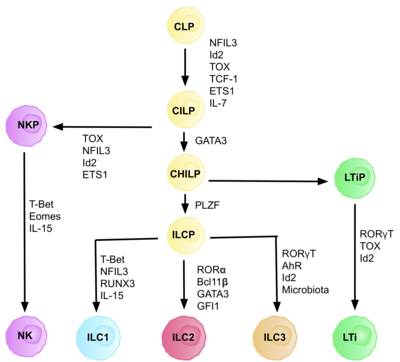ILC2
They express characteristic surface markers and receptors for chemokines, which are involved in distribution of lymphoid cells to specific organ sites.
After stimulation with Th2 polarising cytokines, which are secreted mainly by epithelia (e.g. IL-25, IL-33, TSLP, prostaglandin D2 and leukotriene D4), ILC2s begin to produce IL-5, IL-13, IL-9, IL-4 rapidly.
ILC2s are critical for primary responses to local Th2 antigens e.g. helminths and viruses and that is why ILC2s are abundant in the tissues of skin,[15][16] lungs, liver and gut.
[17] It has been observed that ILC2s originate in the gut, enter lymphatic vessels and then circulate in the bloodstream so they can migrate to other organs to help fight the parasitic infection.
For instance, during Influenza A virus infection, which induces IL-33 production, ILC2s are activated and drive airway hyper-responsiveness.
Besides the type 2 cytokines, ILC2s can also produce IL-6, which induces antibody production by B-cells, acts as a growth factor for plasmablasts and contributes in regulation of T follicular helper cells.
After being stimulated via IL-33 during an infection, they begin to secrete IL-5, leading to an activation of B1 B cells and the production of IgM antibodies.
By producing IL-13, they can initiate smooth muscle contraction and mucus secretion, but also goblet cell hyperplasia if the IL-13 is overexpressed.
[24] Research identified dysregulated responses of ILC2s in adipose tissue as a factor in the development of obesity in mice since ILC2s also play important role in energy homeostasis.
